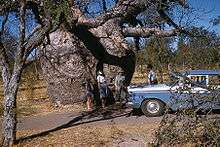Boab Prison Tree, Derby

The Boab Prison Tree, Derby is a 1,500 year old, large hollow Adansonia gregorii (Boab) tree 6 kilometres south of Derby, Western Australia with a girth of 14.7 metres.[1] It had been reputed to have been used in the 1890s as a lockup for indigenous Australian prisoners on their way to Derby for sentencing. There is no evidence that the Derby Prison Tree was ever used for holding prisoners.[2][3]
Kristyn Harman and Elizabeth Grant[4] traced the prison tree myth back to 1948. Around that time, a prominent artist Vlase Zanalis spent eight months camping in and around Derby. Zanalis became intrigued by the region’s extraordinary boab trees. When one of his resulting art works titled ‘The Boab Tree’ was later exhibited at Sydney, the Albany Advertiser described the tree as having in its ‘earlier days’ had its trunk ‘used as a prison of a temporary nature until it was possible to transfer the prisoners to a more permanent abode’. In short, the ‘history’ of another boab tree (located at Wyndham) was transposed to the Derby tree. Over time, this myth has been so often repeated that it has coalesced into a ‘fact’ that is simply not supported by available evidence.[5] The tree is now a tourist attraction.[6]
In the Nyulnyulan languages of the Western Kimberley, boab trees are called ‘larrgadiy’ (alt. spelling larrgadi) and have considerable mythological significance. The ancient trees are often regarded as cherished individuals with unique personalities.
Anthropologist Herbert Basedow was one of the first Europeans to document the Derby Boab Tree. In his 1916 expedition to the Kimberley region, Basedow photographed the tree, captioning the image as “the hollow trunk of a live baobab used by the aborigines as hut and burial place, Mayhall's well, King Sound”. Basedow (1918) wrote: “[t]he natives have long been in the habit of making use of this lusus naturae [freak of nature] as a habitation; it is indeed a dry and comfortable hut” and found bleached human bones lying on the floor, which suggesting Aboriginal people had also made use of the tree for disposing of the dead. The location of human remains seen at the tree by non-Indigenous visitors such as anthropologist Herbert Basedow is a mystery.[7]
In recent years a fence was erected around the tree to protect it from too much human traffic, carving of initials etc., and compacting of surrounding soil by vehicles.

See also
Notes
- ↑ "The wisdom of trees". National Geographic. March 2017.
- ↑ "Derby boab prison tree a myth, say researchers". ABC News. 2017-03-23. Retrieved 2017-04-25.
- ↑ Vincent Serventy, Nature Walkabout (A. H. and A. W. Reed, 1967)
- ↑ "Dark tourism has grown around myth of prison tree". www.adelaide.edu.au. Retrieved 2017-04-25.
- ↑ Grant, Elizabeth; Harman, Kristyn. "Dark tourism, Aboriginal imprisonment and the 'prison tree' that wasn't". The Conversation. Retrieved 2017-04-25.
- ↑ "DANCE OF THE BOAB". The Australian Women's Weekly. National Library of Australia. 2 February 1966. p. 26. Retrieved 11 January 2012.
- ↑ Harman, Kristyn; Grant, Elizabeth (2017). Inventing a colonial dark tourism site: the Derby boab ‘prison tree’. Palgrave McMillan.
References
- Boab Prison Tree, About-Australia.com. Retrieved 1 February 2009.
Coordinates: 17°21′03″S 123°40′12″E / 17.3507°S 123.6699°E